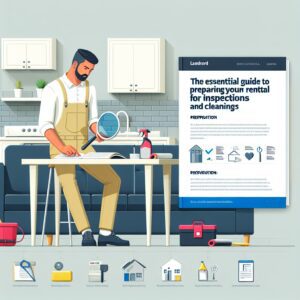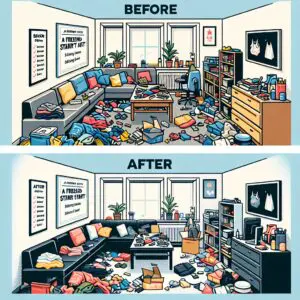1. Understanding Rental Inspections: What Are They?
Welcome to the first section of our comprehensive guide, ‘The Essential Guide to Preparing Your Rental for Inspections and Cleanings.’ This section will focus on the fundamental understanding of rental Inspections – a cornerstone to property management. We delve into the nitty gritty of different types of rental inspections and the integral role they play. It’s a pivotal read for landlords and tenants alike, setting the stage for successful, hassle-free inspections and property maintenance. Join us as we tread the path of mastering property inspections!
1.1 The Importance of Rental Inspections
In the world of property rentals, regular inspections are a critical procedure that ensures the property’s ongoing suitability for its tenants. Rental inspections, essentially, provide a structured opportunity for landlords, property managers, or designated authorities to examine the rental property’s condition. Our property preservation services at A Clean Start often cater to such requirements, assisting property owners in prepping their rental properties.
Understanding and appreciating the importance of rental inspections can significantly aid the symbiosis between tenants and landlords. Firstly, these inspections assist in maintaining the property’s value by identifying minor issues before they exacerbate into costly repairs. Secondly, they safeguard the tenants’ health and safety by addressing any potential hazards that might be lingering unnoticed. Lastly, rental inspections can prove invaluable in ensuring that tenants are abiding by the terms of their lease, thereby maxing out landlord’s return on their investment.
Implementing a regular inspection routine also aids in promoting a good rapport and trust between a landlord and tenant. It gives the tenant a sense of responsibility for the property they inhabit while assuring the landlord of their property’s sustained habitability and appeal. More importantly, it helps nip any property-related issues in the bud, saving potentially significant money and time in the future.
When it comes to professional cleaning and inspection assistance, taking advantage of services like those offered on A Clean Start can be valuable. This contribution to smooth property transitions not only makes the process effortless but also enhances the property’s aesthetic appeal, consequently drawing prospective tenants to your rental property. Consider this your first step in ‘The Essential Guide to Preparing Your Rental for Inspections and Cleanings’.
1.2 Different Types of Rental Inspections
When it comes to rental inspections, there are various types each with a different purpose. The type of inspection primarily depends on the stage of the rental journey you’re in. Comprehending these types and their intent will allow you to foresee potential problem areas and mitigate risks. It integrates the core philosophy of being proactive rather than reactive while managing your rental property – a critical principle outlined in The Essential Guide to Preparing Your Rental for Inspections and Cleanings.
The first inspection type is the move-in inspection. This occurs at the start of the rental journey, providing the benchmark for the rental’s state wherein both tenant and landlord agree on the condition of the property. Another common inspection is the routine inspection, wherein the landlord assesses the ongoing condition of their property, checking for necessary repairs and maintenance, and ensuring the tenant is taking suitable care of their investment.
Next, comes the drive-by inspection. This is less intrusive, with the landlord or property manager simply driving or walking past the rental to check up on basic exterior conditions. Emergency inspections occur when an urgent issue or concern is identified, and immediate access to the property is required. Finally, there’s the move-out inspection, parallel in nature to the move-in inspection, wherein the current state of the property is compared to its original condition, factoring in ordinary wear and tear.
Understanding these different types of inspections can help landlords prepare more effectively and ensure a more seamless inspection process, considerably easing property management. For detailed advice on this and more, don’t hesitate to visit our blog.
1.3 What Inspectors Look For
Being a landlord involves a variety of responsibilities, and one crucial duty is preparing your property for inspections. Inspections are carried out to ensure that your rental property adheres to safety, sanitation, and maintenance guidelines as stipulated under law and in your lease agreement. Although policies may vary based on the local jurisdiction or specific terms of a lease contract, understanding what inspectors typically look for can drastically make your preparation more efficient.
At its core, a rental inspection aims to assess the conditions of certain elements of your property: structural, functional, and aesthetic. These are done to maintain the welfare of your tenants and to ensure the longevity of your property. The inspectors will examine the general cleanliness of your property, hence proper sanitation, free of rubbish and pests, is a must. The structure of your property is also under scrutiny. This involves checking the strength and stability of walls, roofs, and floors. Any sign of damage like leaks, cracks, or deterioration can be cause for concern.
Inspectors will also evaluate the functionality of utilities and facilities, such as plumbing, electrical systems, and heating or cooling units. They will test their operational capability and look for any indication of malfunctions, inefficient performances, or safety issues. This is to ensure that your property provides the basic necessities occupiers need for a comfortable living.
Finally, an inspector will look at the overall aesthetics and livability of your property. This evaluation includes inspecting paintwork for peeling or chipping, checking that windows and doors operate as they should, meeting proper lighting requirements, and appraising the condition of appliances, if applicable. The property should appear well-cared for, comfortable, and inviting. When it comes to rental inspections, it’s important to remember that a well-maintained, inviting property is not only conducive to pass inspection but can also attract and retain tenants, adding value to your rental business in the long run. You can find more such insights and guidance in our blog section.
2. How to Prepare for Rental Inspections
In ‘The Essential Guide to Preparing Your Rental for Inspections and Cleanings,’ getting ready for rental inspections is a key area of focus. This includes detailing initial cleaning steps and consistent maintenance tasks. As an owner, knowing how to prepare in advance can eliminate potential issues down the line, ultimately ensuring your property meets the industry’s regulatory standards. Let’s delve into this all-important topic to help you sail smoothly through any upcoming rental inspections.
2.1 Initial Cleaning
The first step in ‘The Essential Guide to Preparing Your Rental for Inspections and Cleanings’ is carrying out an initial cleaning. This process is crucial because a thorough cleaning sets the groundwork for all the other preparations you will make. Before the property inspector steps foot on your rental property, make sure that everything is spick and span, from the kitchen and bathrooms to the living spaces and bedrooms.
The process of initial cleaning does not have to be overwhelming. Start by eliminating any clutter that may have accumulated during the previous occupancy. Then, focus on getting every surface spotless. If the task proves too demanding, professionals are always on hand to help. Organisations such as A Clean Start offer fabulous property preservation services that can help you achieve the desired cleanliness level. Remember, a clean rental property not only impresses during an inspection, but it also creates a conducive environment for future tenants.
Bear in mind that while the objective is to make the property visually appealing, it goes beyond that. Cleanliness also touches on health and safety. That’s why areas typically prone to germs and bacteria such as the doorknobs, light switches, and bathroom fixtures need to be thoroughly sanitized. Similarly, check that the smoke detectors, carbon monoxide detectors, and fire extinguishers are all functioning properly as part of your preparation process.
Proper garbage disposal is another aspect you can’t overlook during your initial cleaning. Ensure all trash has been appropriately disposed of, and equip your rental property with adequate garbage cans for future use. Offering a clean, well-maintained rental not only ensures a hassle-free inspection but also sets a positive precedent for how tenants should maintain the property. It’s a clear indication of what you expect from them, thus reducing potential disputes down the line.
2.2 Regular Maintenance Tasks
Preparing your rental property for inspections is a crucial task that every landlord and property manager must undertake, and regular maintenance forms a significant part of this. Engaging in routine upkeep not only enhances the aesthetic appeal of the property, but it also mitigates the chance of large-scale damage, thereby increasing the property’s longevity. This, in turn, ensures fewer surprise costs, provides stability, and boosts your reputation as a diligent property manager.
Regular maintenance tasks, range from minor chores to more comprehensive checks. Minor tasks can include dusting, vacuuming, replacing lightbulbs and checking smoke detectors. More significant responsibilities involve seasonal maintenance, like checking heating systems before winter or ensuring proper ventilation in the summer. Endeavour to inspect roofs, gutters, and downspouts semi-annually, check the integrity of the property’s exterior paint, clear out any potential pest habitats, and ensure the plumbing system is functioning optimally.
Attention should also be paid to the property’s landscaping, as well-kept lawns and gardens add to its appeal. Routine maintenance tasks are integral to preparing your rental for inspections and cleanings. By ensuring consistent care for your property, you are essentially preserving its value and making sure that it stands up to the scrutiny of inspections. This, in turn, enables you to stay ahead of any emerging issues and resolve them before they escalate, saving you time, money, and stress down the line.
Beyond the physical tasks, regular reviews of any existing lease agreements and keeping an up-to-date record regarding the property’s state also come under maintenance tasks. Remember, a well-maintained property is the cornerstone of a successful rental experience, and is an investment in your own future as a property manager or landlord. By following this Essential Guide to Preparing Your Rental for Inspections and Cleanings, you’re sure to make the most of your rental experience.
2.3 Addressing Potential Issues
To effectively prepare for rental inspections, addressing potential issues is a vital step that cannot be overlooked. The advantage of this proactive preparation is a shorter inspection period and fewer chances for an oversight which could result in punitive measures. It offers a win-win situation – a property in tip-top condition ready for inspection and a potential boost in its marketability. It’s a significant part of property preservation.
Small repairs like fixing a leaking faucet, replacing a burned-out light bulb, or attending to minor wall cracks can go a long way in showing that the property has been well-maintained. It’s also important to bring any upgrades or modifications to code. For instance, if a new fire extinguisher has been installed or a smoke detector replaced, ensure they meet the local fire safety standards. These actions, while seemingly minor, align well with the principles detailed in ‘The Essential Guide to Preparing Your Rental for Inspections and Cleanings’ and can save a property owner from unnecessary complications during inspections.
From a cleanliness perspective, a comprehensive deep cleaning will likely be necessary. This includes common areas and those often overlooked, like behind appliances and under furniture. If the cleaning task seems daunting, professional help from a reliable cleaning service like A Clean Start could save time and ensure a thorough job. Remember, a clean and well-maintained property not only passes inspections but also attracts and retains quality tenants.
In conclusion, rental inspections necessitate thorough preparation and addressing potential issues head-on. The effort spent will likely pay off in the form of positive inspection results and the continued success of your rental property business. By following ‘The Essential Guide to Preparing Your Rental for Inspections and Cleanings’, you can ensure your property continually meets and exceeds the expected standards.
3. Methods of Deep Cleaning Your Rental Property
A pivotal part of our Essential Guide to Preparing Your Rental for Inspections and Cleanings is mastering the art of deep cleaning your property. This includes understanding the various strategic tasks required for impeccable cleanliness, utilizing a well-articulated cleaning plan, and when necessary, enlisting the help of professionals. Embark on this journey to ensure your rental unit stands out, attracting the right tenants and acing every inspection with flying colors.
3.1 Preparing a Cleaning Plan
Before you embark on the significant task of deep cleaning your rental property, it would be beneficial to prepare a detailed cleaning plan. This document should serve as your step-by-step guide, ensuring you cover every area of the property and leave no corner unchecked. A successful cleaning plan effectively incorporates the knowledge acquired from ‘The Essential Guide to Preparing Your Rental for Inspections and Cleanings’ and customizes it for your unique property and situation.
Firstly, segment the property into manageable chunks – perhaps by room or property section – and devote adequate time and resources to each. Be thorough with your plan; for each segment, list specific tasks to be completed, necessary cleaning supplies, and appropriate techniques. Bear in mind, the ‘ultimate clean’ differs for various areas; for example, carpet cleaning will differ greatly from bathroom tile cleaning.
Finally, remember to factor in the time required for the cleaning process. Deep cleaning is not a sprint but a marathon and rushing could lead to overlooked areas or poor-quality cleaning. Thus, maintaining a reasonable schedule can also prevent overwhelming fatigue, in turn ensuring that your rental property is at its cleanest state, ready for inspections and future use.
3.2 Essential Cleaning Tasks
Ensuring your rental property shines with cleanliness isn’t an overnight task; it requires a systematic approach to make an ever-lasting impression during inspections and cleanings. The Essential Cleaning Tasks form the backbone of this process, making your property ready for scrutiny at any moment. These tasks primarily focus on cleaning the most critical areas of your home that possibly gather most of the dirt and dust due to frequent usages.
These areas usually include the kitchen, bathroom, bedroom, and living area. In the kitchen, all appliances, countertops, and cabinets should be wiped clean. Any dirt or grime on the stovetop, in the oven, or the exhaust fans should be removed diligently. Moving on to the bathroom, the tiles, showers, bathtubs, sinks, and toilets need to be thoroughly cleaned and sanitized.
A clean bedroom offers a welcoming vibe to any visitor. Make sure you clean the wardrobe, bed frame, functionaries, and remove any look of wear. The last but no-way the least is the living area — clean the furniture, dust the TV, and check the corners for any cobwebs. Ensure a meticulous clean-up of these high-traffic areas which will contribute to a positive impression during inspections or cleanings.
You may think that these cleaning tasks sound hectic and time-consuming. However, employing a systematised approach by breaking down these tasks and tackling them progressively can ease the process. Remember, a clean rental property is more likely to attract quality tenants and pass any inspections with flying colours. For more information regarding thorough cleaning, refer to our blog post on the 2024 Guide for Real Estate Resilience.
3.3 Hiring Professional Services
It’s not uncommon for property owners to feel overwhelmed by the plethora of cleaning tasks that follow once the tenants leave their rental properties. That’s where, hiring professional services comes into play. Professional cleaning services, like A Clean Start, not only take a load off your shoulders but also ensure a thorough and deep cleaning with little to no hassle. Additionally, these professionals bring along experience and proficiency that safeguard your property during cleanup, adding an extra layer to your rental’s overall preservation.
Hiring professional services becomes crucial when it comes to cleaning corners and areas that are often overlooked during a regular cleaning sweep. The pros have access to commercial grade cleaning supplies and equipment, which elevates the level of cleanliness and hygiene in your rental property, giving the potential tenants a positively impressive first look. Not to mention, professionals are adept at navigating the cleaning challenges that come along with the diverse types of residential properties. If you’re wondering who to reach out to for your deep cleaning needs, consider contacting A Clean Start. They’ve been known to provide quality services and delivering on the promise of a cleaner, more attractive rental ready for inspection and new tenancy.
4. Post-Cleaning and Inspection Steps
In “The Essential Guide to Preparing Your Rental for Inspections and Cleanings”, the segment on Post-Cleaning and Inspection Steps is equally vital. After an exhaustive cleaning session and inspection, it’s important to follow certain procedures such as meticulously reviewing inspection reports and undertaking necessary repairs. These actions help to maintain the robustness of your rental property and ensure it remains in peak condition following official examinations.
4.1 Reviewing Inspection Reports
The last stage in ‘The Essential Guide to Preparing Your Rental for Inspections and Cleanings’ is understanding and interpreting the results of your inspection. After a thorough cleaning and inspection, you’ll receive an inspection report. It’s crucial to review these documents carefully, as they provide a comprehensive account of your rental property’s current condition and are the benchmark for your subsequent cleaning and inspection practices.
The inspection reports will commonly outline the general cleanliness, state of appliances, safety features, structural conditions, and other essential elements of your property. Noting down areas highlighted for improvement can help you streamline the process for future inspections and cleaning. Taking the time to comprehend the detailed findings in these reports will ultimately benefit you, as it can inform your next steps and strategies in maintaining your property. If there are questions or concerns about the report’s findings, don’t hesitate to get in touch with the inspector or the cleaning company. You may check out the contact us page of a trustworthy cleaning service provider.
Regular rental property inspection and cleaning may seem like an arduous task, but it is crucial in ensuring the longevity of your investment. Being proactive in this process not only sustains the appeal of your property but also keeps it safe and habitable for tenants. A well-inspected and cleaned rental property increases the chances of retaining tenants and attracting potential ones, ensuring the inflow of rental income for you, the owner.
Consider this ‘The Essential Guide to Preparing Your Rental for Inspections and Cleanings’ as your first step towards a more organized, productive, and rewarding property rental business. By ensuring that you’re systematic and meticulous about your property’s cleaning and inspection, you can look forward to an investment that gives back abundant returns. For additional reading or related resources on property maintenance, feel free to explore our blog section.
4.2 Making Necessary Repairs
After an inspection or cleaning, it is crucial to address any issues that may have arisen, and this process involves making necessary repairs. The ultimate goal is to ensure your rental property is in the best possible condition, resonating with the essential principle of “The Essential Guide to Preparing Your Rental for Inspections and Cleanings.” Notably, accomplishing this requires a dedicated approach and meticulous attention to detail to extend the lifespan of the property and promote tenant satisfaction.
In our Essential Guide to Preparing Your Rental for Inspections and Cleanings, we stress the value of swift repairs. It is always prudent to immediately repair any discovered issues, which not only prevents further damage but also communicates to your renters that their living environment matters to you. For those particularly hefty repairs that need professional intervention, consider reaching out to experienced and reputable property preservation services like A Clean Start Property Preservation Services. They can provide an extensive range of services to maintain your rental property’s value and aesthetical appeal.
When embarking on repairs, remember to address the issues thoroughly, ensuring no stones are left unturned. Inspections and cleanings can expose hidden issues, from a simple leak to extensive structural problems. The key is to carry out the repairs in a way that the problem won’t recur in future. This strategy is central to the effectiveness of the repairs and the ultimate goal of having your rental ready for future inspections and cleanings.
It’s important to note that it’s not only about the interior of the home, but also the exterior. Outdoor aspects of the property such as gardens, patios, or front porch require the same level of attention. The holistic approach ensures all elements, both inside and out, are in the best shape, leaving a lasting impression on prospective tenants and property inspectors alike. Finally, remember – quality is key; repair work carried out must stand the test of time and recurrent inspections.
4.3 Maintaining the Property Post-Inspection
It’s critically essential that the maintenance of a rental property doesn’t only end at the inspection stage. Property managers should understand that post-inspection upkeep ranks high on the list in “The Essential Guide to Preparing Your Rental for Inspections and Cleanings.” Offering a consistently clean and well-maintained property is an organic way to attract and retain quality tenants.
Following the inspection, property managers should ensure that all identified issues have been resolved and that the cleaning checklist is completed. Updating your inventory list is also vital at this stage. This will not only help you maintain accurate records but also simplifies the process when preparing for future inspections. Always remember, maintaining your property post-inspection is a step towards securing your investment and enhancing your property’s value. Frequent monitoring and quick fixes can prevent minor issues from escalating into significant problems. Check out our guide on property preservation for more tips on maintaining your property.
Part of maintaining your rental post-inspection is ensuring your property’s cleaning routine is adhered to. Regular cleaning can keep your property in top shape for longer and reduce wear and tear. Engaging professional cleaning services such as ACleanStart can help maintain high standards of cleanliness ensuring your property is always rent-ready.
Finally, communication with your tenants remains crucial even after inspections. Keeping your tenants looped in on any updates or changes post-inspection promotes transparency and can offer them reassurance about their living space. Ongoing communication and consideration for your tenant’s comfort can lead to long-term lease renewals and positive reviews which ultimately add to your property’s reputation. In the end, understanding that the maintenance of your rental property is a continuous process is the key take-away from this essential guide to preparing your rental for inspections and cleanings.










